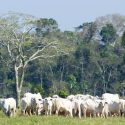Reading the fine print: Can conservation easements allow adaptive management?
White oaks are characteristic trees of the oak savannas of Southern Wisconsin. They can become threatened when forest management or invasive species control are not identified as a goal requiring active management when writing a conservation easement.
Photo: Ann Calhoun/The Nature Conservancy
As conservation easements gain popularity for protecting privately owned land, a UW–Madison scientist is trying to unravel a difficult question: In the face of environmental change, how well can these easements satisfy their conservation goals?
In the online edition of Environmental Management, Adena Rissman, an assistant professor of forest and wildlife ecology, published a major study of 34 conservation easements in Wisconsin. The easements were held by eight agencies and organization, ranging in size from the U.S. government down to local land trusts.
Rissman, former post-doctoral researcher Menka Bihari, and a team of graduate students examined the easement contracts and interviewed staff, seeking to ascertain how well the easement could cope with changing conditions.

Adena Rissman
Through a conservation easement, a landowner contracts to sell certain rights, such as the right to subdivide for development. The binding contract gives a variable list of rights to the easement holder, which is a government agency or a private, nonprofit land trust.
The project was rooted in a graduate seminar, Rissman says. “I wanted to engage students in the whole research process, so whoever joined the class became part of this project, and we were able to integrate research, training and coursework on conservation.”
In environmental science, change is constant, Rissman says. “We are seeing a lot of development, invasive species, climate change that is creating more intense storms, floods, rainfall, drought — and this is on top of changing attitudes about what it means to conserve land.”
Nonetheless, easements remain fixed, legal documents that may prohibit the very tactics that modern conservationists rely on to protect land.
Some easements signed in the 1990s, Rissman points out, prevent cutting of vegetation or spraying herbicide, yet these techniques are now critical for managing invasive species. “To reach your goals, you often need to have a more active role in management, but the easement tool does not always provide the ability to perform active land management.”
According to the National Conservation Easement Database, more than 18 million acres of land in the United States was protected by a conservation easement by 2012.
“[Easements] are not a one-size-fits-all tool, and that’s good. But there is so little consistency, you really have to read each one … to know what they mean.”
Adena Rissman
The largest conservation easements in Wisconsin cover development rights on northern forest land. For example, in May 2012, state officials announced a two-part easement on 67,000 acres in Northwest Wisconsin, mainly in Douglas and Washburn Counties.
Although ecological monitoring is critical for determining whether management changes are needed, most of the easements studied, including all of the open-space or forestry easements, did not provide the right to conduct such monitoring.
Surprisingly, Rissman says, “some land trusts are doing more monitoring than government agencies. We thought that big agencies, with bigger budgets and staff, would be out there all the time. But either they don’t have the capacity, or they don’t see it as a high priority.”
Easements can cut the cost of conservation and attract landowners who would not sell outright, but still want to ensure that the land will stay as a forest, wetland or grassland, Rissman notes.
“Easements don’t just mean one thing,” Rissman adds. “They are not a one-size-fits-all tool, and that’s good. But there is so little consistency, you really have to read each one, talk to people about each one, to know what they mean.”
The flexibility needed to confront environmental changes can also backfire, Rissman acknowledges. “When there is discretion on the part of the conservation organization, there is an opportunity for the landowner to exert pressure to make changes that do not necessarily benefit conservation.”
As easements continue to gain ground as a major conservation tool, Rissman advocates more attention from the start. “I would like us to refocus on the drafting process, so the terms are more comprehensible and we get a plan for effective monitoring and management of the property. We want to see conservation policy that is more adaptive, more able to meet those conservation goals on the site, given the inevitable changes in conditions.”
Tags: conservation, environment



